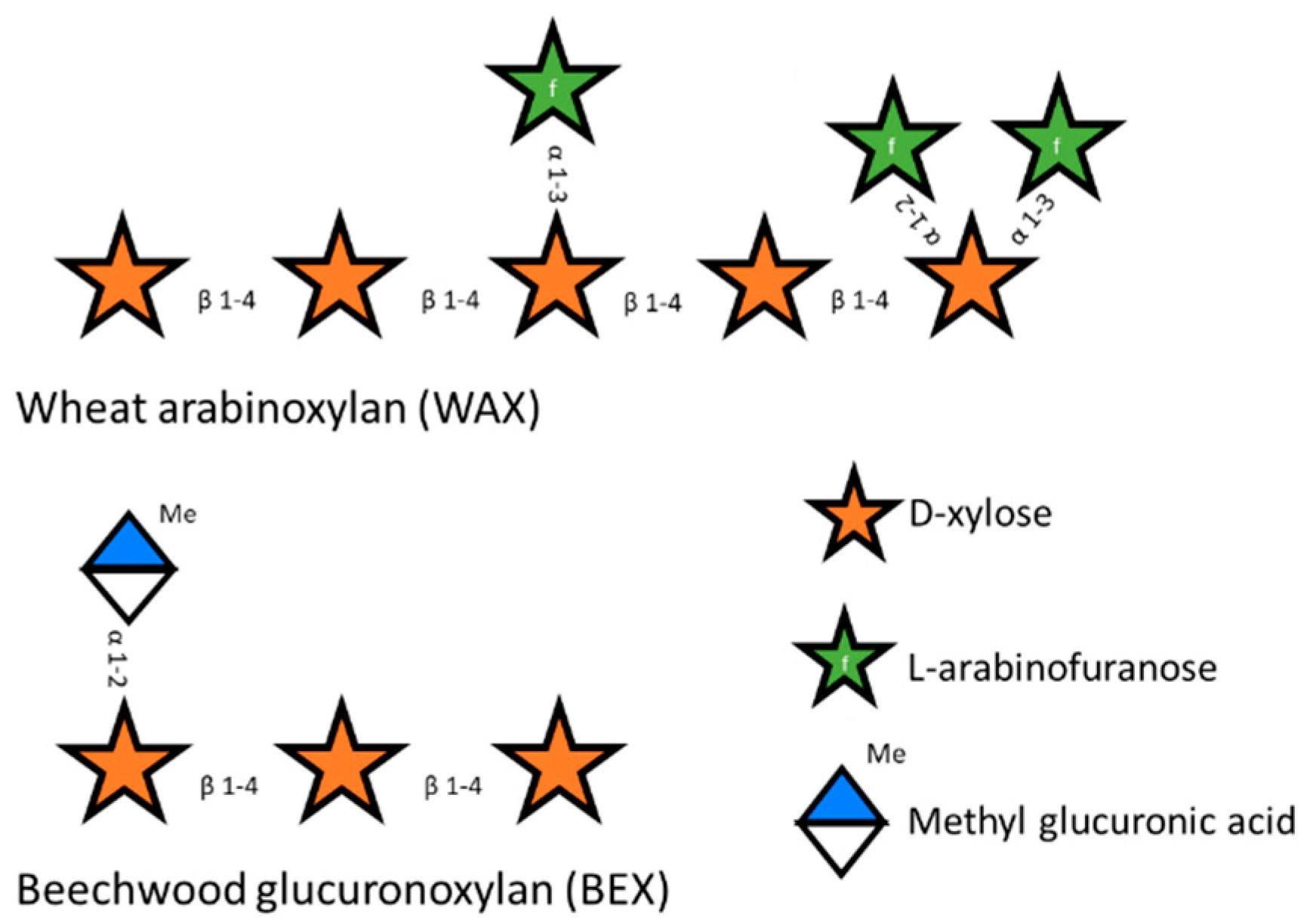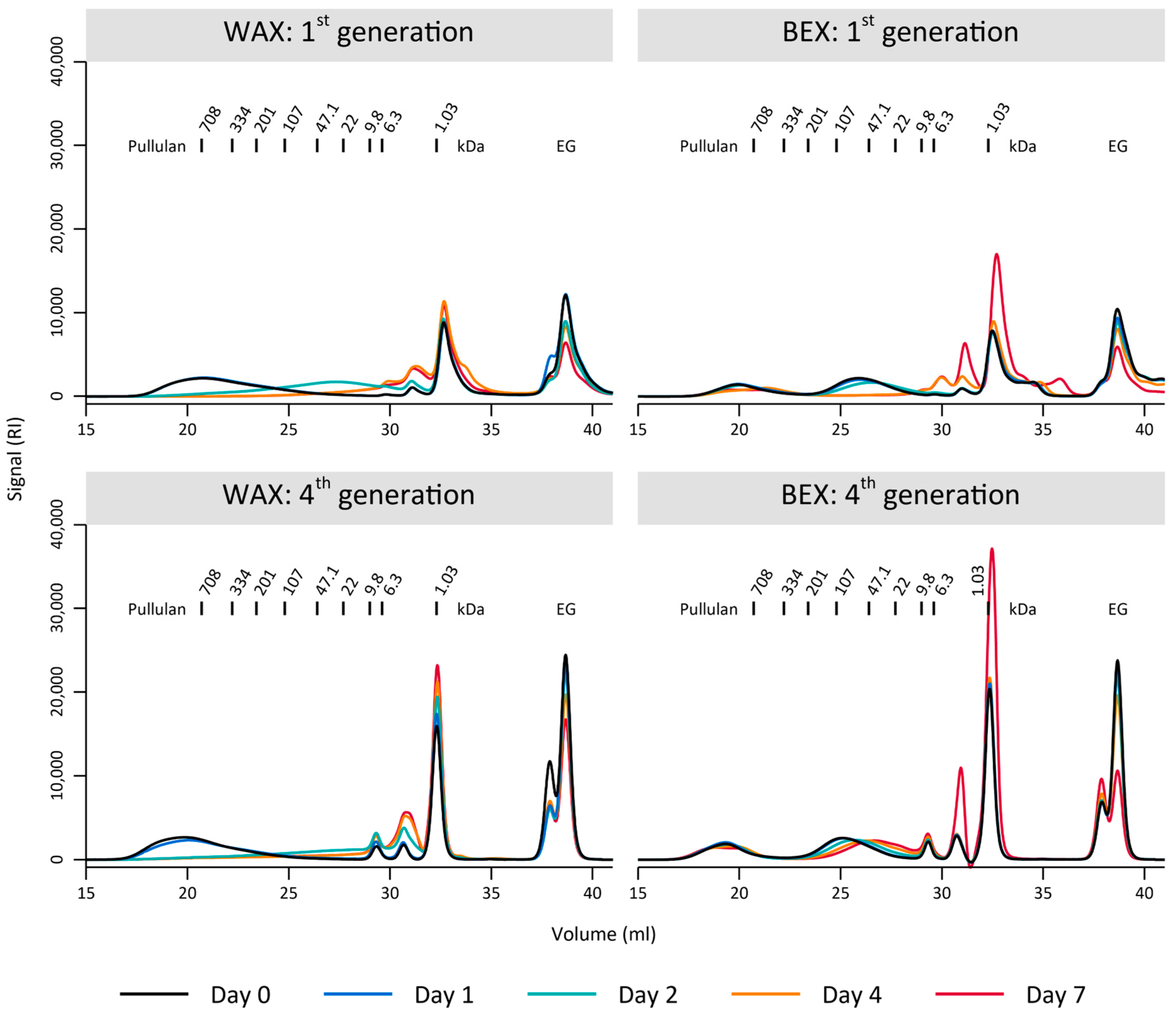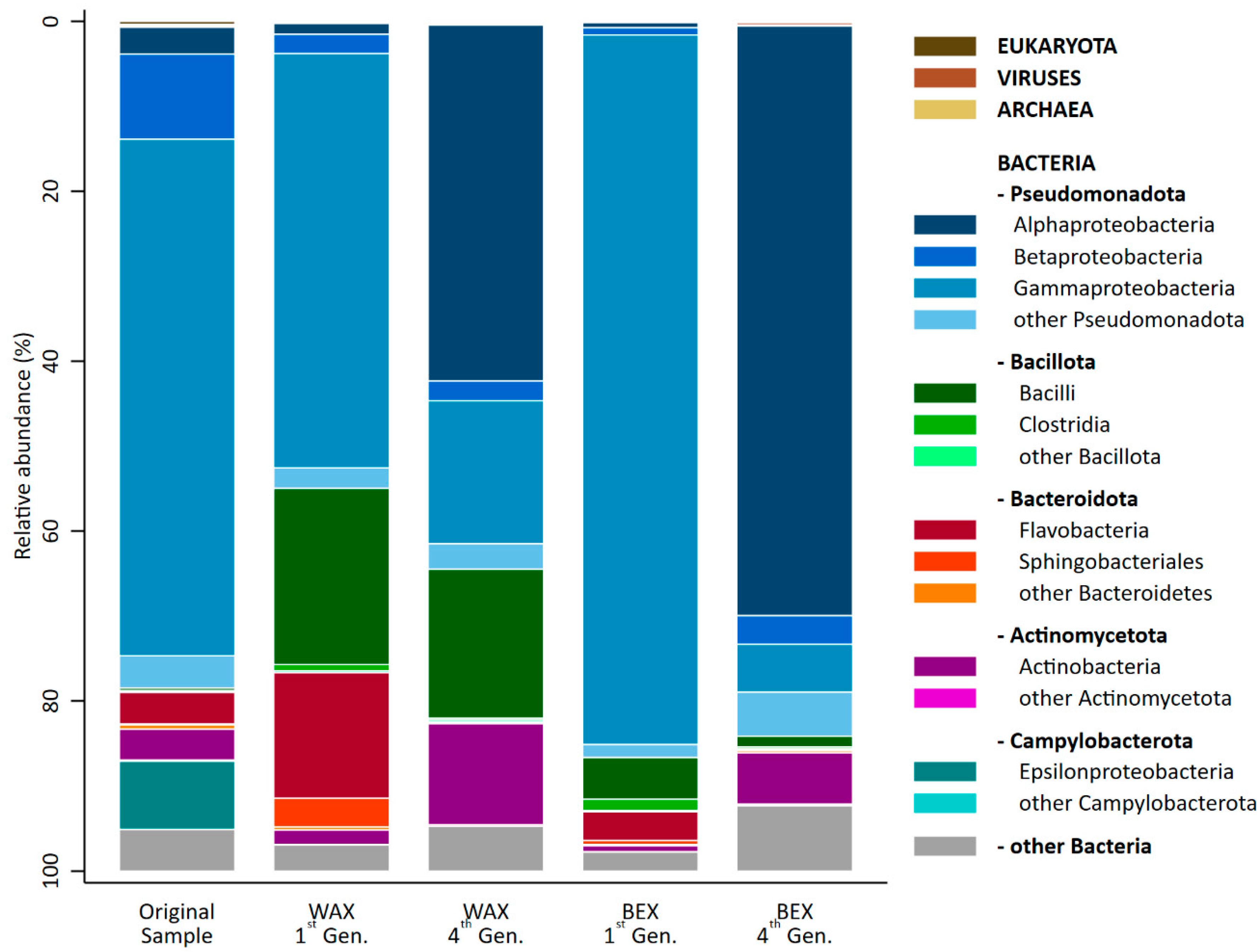Enrichment of Aquatic Xylan-Degrading Microbial Communities
Abstract
1. Introduction
2. Material and Methods
2.1. Sampling and Site Description
2.2. Substrate Preparation
2.3. Bacterial Enrichment
2.4. Metagenomic Sequencing
2.5. Gel Permeation Chromatography
3. Results and Discussion
3.1. Polysaccharide Degradation and Bacterial Growth
3.2. Taxonomic Profiling
3.3. Enrichment of Genes Associated with Xylan Degradation and Catabolism
4. Conclusions
Supplementary Materials
Author Contributions
Funding
Data Availability Statement
Acknowledgments
Conflicts of Interest
References
- de Jong, E.; Higson, A.; Walsh, P.; Wellisch, M. Bio-Based Chemicals: Value Added Products from Biorefinerie. IEA Bioenergy—Task 42 Biorefinery. 2012. Available online: https://www.nnfcc.co.uk/publications/biorefinery-biobased-chemicals (accessed on 1 July 2024).
- Ginni, G.; Kavitha, S.; Yukesh Kannah, R.; Bhatia, S.K.; Adish Kumar, S.; Rajkumar, M.; Kumar, G.; Pugazhendhi, A.; Chi, N.T.L.; Rajesh Banu, J. Valorization of Agricultural Residues: Different Biorefinery Routes. J. Environ. Chem. Eng. 2021, 9, 105435. [Google Scholar] [CrossRef]
- Himmel, M.E.; Ding, S.-Y.; Johnson, D.K.; Adney, W.S.; Nimlos, M.R.; Brady, J.W.; Foust, T.D. Biomass Recalcitrance: Engineering Plants and Enzymes for Biofuels Production. Science 2007, 315, 804–807. [Google Scholar] [CrossRef] [PubMed]
- Okolie, J.A.; Nanda, S.; Dalai, A.K.; Kozinski, J.A. Chemistry and Specialty Industrial Applications of Lignocellulosic Biomass. Waste Biomass Valorization 2021, 12, 2145–2169. [Google Scholar] [CrossRef]
- Arantes, V.; Saddler, J.N. Cellulose Accessibility Limits the Effectiveness of Minimum Cellulase Loading on the Efficient Hydrolysis of Pretreated Lignocellulosic Substrates. Biotechnol. Biofuels 2011, 4, 3. [Google Scholar] [CrossRef] [PubMed]
- Bichot, A.; Delgenès, J.P.; Méchin, V.; Carrère, H.; Bernet, N.; García-Bernet, D. Understanding Biomass Recalcitrance in Grasses for Their Efficient Utilization as Biorefinery Feedstock. Rev. Environ. Sci. Bio/Technol. 2018, 17, 707–748. [Google Scholar] [CrossRef]
- Cortes-Tolalpa, L.; Salles, J.F.; van Elsas, J.D. Bacterial Synergism in Lignocellulose Biomass Degradation-Complementary Roles of Degraders as Influenced by Complexity of the Carbon Source. Front. Microbiol. 2017, 8, 1628. [Google Scholar] [CrossRef] [PubMed]
- Scheller, H.V.; Ulvskov, P. Hemicelluloses. Annu. Rev. Plant Biol. 2010, 61, 263–289. [Google Scholar] [CrossRef] [PubMed]
- Mosbech, C.; Holck, J.; Meyer, A.S.; Agger, J.W. The Natural Catalytic Function of CuGE Glucuronoyl Esterase in Hydrolysis of Genuine Lignin–Carbohydrate Complexes from Birch. Biotechnol. Biofuels 2018, 11, 71. [Google Scholar] [CrossRef]
- Vismeh, R.; Lu, F.; Chundawat, S.P.S.; Humpula, J.F.; Azarpira, A.; Balan, V.; Dale, B.E.; Ralph, J.; Jones, A.D. Profiling of Diferulates (Plant Cell Wall Cross-Linkers) Using Ultrahigh-Performance Liquid Chromatography-Tandem Mass Spectrometry. Analyst 2013, 138, 6683. [Google Scholar] [CrossRef]
- de Oliveira, D.M.; Finger-Teixeira, A.; Rodrigues Mota, T.; Salvador, V.H.; Moreira-Vilar, F.C.; Correa Molinari, H.B.; Craig Mitchell, R.A.; Marchiosi, R.; Ferrarese-Filho, O.; Dantas dos Santos, W. Ferulic Acid: A Key Component in Grass Lignocellulose Recalcitrance to Hydrolysis. Plant Biotechnol. J. 2015, 13, 1224–1232. [Google Scholar] [CrossRef]
- Wang, Z.; Deuss, P.J. The Isolation of Lignin with Native-like Structure. Biotechnol. Adv. 2023, 68, 108230. [Google Scholar] [CrossRef]
- Raikwar, D.; Van Aelst, K.; Vangeel, T.; Corderi, S.; Van Aelst, J.; Van den Bosch, S.; Servaes, K.; Vanbroekhoven, K.; Elst, K.; Sels, B.F. Elucidating the Effect of the Physicochemical Properties of Organosolv Lignins on Its Solubility and Reductive Catalytic Depolymerization. Chem. Eng. J. 2023, 461, 141999. [Google Scholar] [CrossRef]
- Abu-Omar, M.M.; Barta, K.; Beckham, G.T.; Luterbacher, J.S.; Ralph, J.; Rinaldi, R.; Román-Leshkov, Y.; Samec, J.S.M.; Sels, B.F.; Wang, F. Guidelines for Performing Lignin-First Biorefining. Energy Environ. Sci. 2021, 14, 262–292. [Google Scholar] [CrossRef]
- Tarasov, D.; Leitch, M.; Fatehi, P. Lignin–Carbohydrate Complexes: Properties, Applications, Analyses, and Methods of Extraction: A Review. Biotechnol. Biofuels 2018, 11, 269. [Google Scholar] [CrossRef] [PubMed]
- Carvalho, D.M.D.; Lahtinen, M.H.; Lawoko, M.; Mikkonen, K.S. Enrichment and Identification of Lignin-Carbohydrate Complexes in Softwood Extract. ACS Sustain. Chem. Eng. 2020, 8, 11795–11804. [Google Scholar] [CrossRef]
- Rogowski, A.; Briggs, J.A.; Mortimer, J.C.; Tryfona, T.; Terrapon, N.; Lowe, E.C.; Baslé, A.; Morland, C.; Day, A.M.; Zheng, H.; et al. Glycan Complexity Dictates Microbial Resource Allocation in the Large Intestine. Nat. Commun. 2015, 6, 7481. [Google Scholar] [CrossRef]
- Ventorino, V.; Aliberti, A.; Faraco, V.; Robertiello, A.; Giacobbe, S.; Ercolini, D.; Amore, A.; Fagnano, M.; Pepe, O. Exploring the Microbiota Dynamics Related to Vegetable Biomasses Degradation and Study of Lignocellulose-Degrading Bacteria for Industrial Biotechnological Application. Sci. Rep. 2015, 5, 8161. [Google Scholar] [CrossRef] [PubMed]
- Bout, A.E.; Pfau, S.F.; van der Krabben, E.; Dankbaar, B. Residual Biomass from Dutch Riverine Areas-from Waste to Ecosystem Service. Sustainability 2019, 11, 509. [Google Scholar] [CrossRef]
- Cardman, Z.; Arnosti, C.; Durbin, A.; Ziervogel, K.; Cox, C.; Steen, A.D.; Teske, A. Verrucomicrobia Are Candidates for Polysaccharide-Degrading Bacterioplankton in an Arctic Fjord of Svalbard. Appl. Environ. Microbiol. 2014, 80, 3749–3756. [Google Scholar] [CrossRef]
- Gilbert, J.A.; Steele, J.A.; Caporaso, J.G.; Steinbrück, L.; Reeder, J.; Temperton, B.; Huse, S.; McHardy, A.C.; Knight, R.; Joint, I.; et al. Defining Seasonal Marine Microbial Community Dynamics. ISME J. 2012, 6, 298–308. [Google Scholar] [CrossRef]
- Parvathi, A.; Jasna, V.; Aswathy, V.K.; Nathan, V.K.; Aparna, S.; Balachandran, K.K. Microbial Diversity in a Coastal Environment with Co-Existing Upwelling and Mud-Banks along the South West Coast of India. Mol. Biol. Rep. 2019, 46, 3113–3127. [Google Scholar] [CrossRef] [PubMed]
- Marín, P.; Martirani-Von Abercron, S.M.; Urbina, L.; Pacheco-Sánchez, D.; Castañeda-Cataña, M.A.; Retegi, A.; Eceiza, A.; Marqués, S. Bacterial Nanocellulose Production from Naphthalene. Microb. Biotechnol. 2019, 12, 662–676. [Google Scholar] [CrossRef] [PubMed]
- Wood, D.E.; Lu, J.; Langmead, B. Improved Metagenomic Analysis with Kraken 2. Genome Biol. 2019, 20, 257. [Google Scholar] [CrossRef] [PubMed]
- Buchfink, B.; Reuter, K.; Drost, H.G. Sensitive Protein Alignments at Tree-of-Life Scale Using DIAMOND. Nat. Methods 2021, 18, 366–368. [Google Scholar] [CrossRef]
- Ebringerová, A. Structural Diversity and Application Potential of Hemicelluloses. Macromol. Symp. 2006, 232, 1–12. [Google Scholar] [CrossRef]
- Netrusov, A.I.; Liyaskina, E.V.; Kurgaeva, I.V.; Liyaskina, A.U.; Yang, G.; Revin, V.V. Exopolysaccharides Producing Bacteria: A Review. Microorganisms 2023, 11, 1541. [Google Scholar] [CrossRef]
- Korenblum, E.; Jiménez, D.J.; van Elsas, J.D. Succession of Lignocellulolytic Bacterial Consortia Bred Anaerobically from Lake Sediment. Microb. Biotechnol. 2016, 9, 224–234. [Google Scholar] [CrossRef] [PubMed]
- Behera, P.; Mohapatra, M.; Kim, J.Y.; Adhya, T.K.; Pattnaik, A.K.; Rastogi, G. Spatial and Temporal Heterogeneity in the Structure and Function of Sediment Bacterial Communities of a Tropical Mangrove Forest. Environ. Sci. Pollut. Res. 2019, 26, 3893–3908. [Google Scholar] [CrossRef]
- Francis, B.; Urich, T.; Mikolasch, A.; Teeling, H.; Amann, R. North Sea Spring Bloom-Associated Gammaproteobacteria Fill Diverse Heterotrophic Niches. Environ. Microbiome 2021, 16, 15. [Google Scholar] [CrossRef]
- Carlos, C.; Fan, H.; Currie, C.R. Substrate Shift Reveals Roles for Members of Bacterial Consortia in Degradation of Plant Cell Wall Polymers. Front. Microbiol. 2018, 9, 364. [Google Scholar] [CrossRef]
- Parab, P.D.; Khandeparker, R.D.; Shenoy, B.D.; Sharma, J. Phylogenetic Diversity of Culturable Marine Bacteria from Mangrove Sediments of Goa, India: A Potential Source of Xylanases Belonging to Glycosyl Hydrolase Family 10. Appl. Biochem. Microbiol. 2020, 56, 718–728. [Google Scholar] [CrossRef]
- Jiménez, D.J.; Dini-Andreote, F.; Van Elsas, J.D. Metataxonomic Profiling and Prediction of Functional Behaviour of Wheat Straw Degrading Microbial Consortia. Biotechnol. Biofuels 2014, 7, 92. [Google Scholar] [CrossRef] [PubMed]
- Do, T.H.; Nguyen, T.T.; Nguyen, T.N.; Le, Q.G.; Nguyen, C.; Kimura, K.; Truong, N.H. Mining Biomass-Degrading Genes through Illumina-Based de Novo Sequencing and Metagenomic Analysis of Free-Living Bacteria in the Gut of the Lower Termite Coptotermes Gestroi Harvested in Vietnam. J. Biosci. Bioeng. 2014, 118, 665–671. [Google Scholar] [CrossRef]
- Crotti, E.; Rizzi, A.; Chouaia, B.; Ricci, I.; Favia, G.; Alma, A.; Sacchi, L.; Bourtzis, K.; Mandrioli, M.; Cherif, A.; et al. Acetic Acid Bacteria, Newly Emerging Symbionts of Insects. Appl. Environ. Microbiol. 2010, 76, 6963–6970. [Google Scholar] [CrossRef]
- Wong, C.N.A.; Ng, P.; Douglas, A.E. Low-Diversity Bacterial Community in the Gut of the Fruitfly Drosophila Melanogaster. Environ. Microbiol. 2011, 13, 1889–1900. [Google Scholar] [CrossRef] [PubMed]
- Iino, T.; Suzuki, R.; Kosako, Y.; Ohkuma, M.; Komagata, K.; Uchimura, T. Acetobacter Okinawensis Sp. Nov., Acetobacter Papayae Sp. Nov., and Acetobacter Persicus Sp. Nov.; Novel Acetic Acid Bacteria Isolated from Stems of Sugarcane, Fruits, and a Flower in Japan. J. Gen. Appl. Microbiol. 2012, 58, 235–243. [Google Scholar] [CrossRef][Green Version]
- Wardman, J.F.; Bains, R.K.; Rahfeld, P.; Withers, S.G. Carbohydrate-Active Enzymes (CAZymes) in the Gut Microbiome. Nat. Rev. Microbiol. 2022, 20, 542–556. [Google Scholar] [CrossRef]
- Thomas, F.; Hehemann, J.H.; Rebuffet, E.; Czjzek, M.; Michel, G. Environmental and Gut Bacteroidetes: The Food Connection. Front. Microbiol. 2011, 2, 9588. [Google Scholar] [CrossRef] [PubMed]
- The Gene Ontology Consortium; Aleksander, S.A.; Balhoff, J.; Carbon, S.; Cherry, J.M.; Drabkin, H.J.; Ebert, D.; Feuermann, M.; Gaudet, P.; Harris, N.L.; et al. The Gene Ontology Knowledgebase in 2023. Genetics 2023, 224, iyad031. [Google Scholar] [CrossRef]
- Ashburner, M.; Ball, C.A.; Blake, J.A.; Botstein, D.; Butler, H.; Cherry, J.M.; Davis, A.P.; Dolinski, K.; Dwight, S.S.; Eppig, J.T.; et al. Gene Ontology: Tool for the Unification of Biology. Nat. Genet. 2000, 25, 25–29. [Google Scholar] [CrossRef]
- Chandravanshi, M.; Sharma, A.; Dasgupta, P.; Mandal, S.K.; Kanaujia, S.P. Identification and Characterization of ABC Transporters for Carbohydrate Uptake in Thermus Thermophilus HB8. Gene 2019, 696, 135–148. [Google Scholar] [CrossRef] [PubMed]
- Schneider, E. ABC Transporters Catalyzing Carbohydrate Uptake. Res. Microbiol. 2001, 152, 303–310. [Google Scholar] [CrossRef] [PubMed]




| OS | WAX1 | WAX4 | BEX1 | BEX4 | |
|---|---|---|---|---|---|
| Total reads | 10,924,419 | 18,135,162 | 14,350,049 | 16,357,164 | 19,858,928 |
| Classified reads (%) | 45.32% | 61.96% | 49.70% | 72.67% | 27.26% |
| of which: | |||||
| - Classified kingdom (%) | 98.33% | 99.20% | 98.91% | 99.17% | 95.81% |
| - Classified species (%) | 40.86% | 50.56% | 50.49% | 38.17% | 51.38% |
| Classified species (reads) | 2,022,805 | 5,680,604 | 3,600,769 | 4,536,935 | 2,781,849 |
| Shannon Diversity Index (H) | 4.73 | 4.76 | 5.23 | 4.00 | 4.91 |
| Shannon Equitability Index (E) | 0.51 | 0.52 | 0.58 | 0.44 | 0.56 |
| Species (all) | 9095 | 8592 | 7258 | 8557 | 6241 |
| >100 reads | 2175 | 2565 | 2883 | 1259 | 2057 |
| >5000 reads | 51 | 105 | 85 | 66 | 41 |
| >20,000 reads | 12 | 33 | 16 | 27 | 20 |
| Phylum | Class | Species | % OS | % WAX1 | % WAX4 | % BEX1 | % BEX4 |
|---|---|---|---|---|---|---|---|
| Actinomycetota | Actinomycetes | Mycobacterium canettii | 0.74 | 0.31 | 0.41 | 0.22 | 2.27 |
| Bacillota | Bacilli | Exiguobacterium mexicanum | 0.00 | 1.64 | 0.00 | 0.00 | 0.00 |
| Bacillota | Bacilli | Leuconostoc mesenteroides | 0.00 | 1.17 | 0.00 | 0.00 | 0.00 |
| Bacillota | Bacilli | Niallia circulans | 0.00 | 4.94 | 8.55 | 0.02 | 0.04 |
| Bacillota | Clostridia | Clostridium intestinale | 0.00 | 0.51 | 0.00 | 1.14 | 0.00 |
| Bacteroidota | Flavobacteriia | Cloacibacterium caeni | 0.00 | 2.75 | 0.00 | 0.32 | 0.00 |
| Bacteroidota | Flavobacteriia | Cloacibacterium normanense | 0.00 | 1.20 | 0.00 | 0.15 | 0.00 |
| Bacteroidota | Sphingobacteriia | Sphingobacterium hotanense | 0.00 | 2.10 | 0.00 | 0.24 | 0.00 |
| Campylobacterota | Epsilonproteobacteria | Arcobacter suis | 1.14 | 0.00 | 0.00 | 0.00 | 0.00 |
| Campylobacterota | Epsilonproteobacteria | Arcobacter venerupis | 1.82 | 0.00 | 0.00 | 0.00 | 0.00 |
| Pseudomonadota | Alphaproteobacteria | Acetobacter aceti | 0.00 | 0.00 | 0.01 | 0.00 | 2.42 |
| Pseudomonadota | Alphaproteobacteria | Acetobacter ghanensis | 0.00 | 0.00 | 0.00 | 0.00 | 3.91 |
| Pseudomonadota | Alphaproteobacteria | Acetobacter orientalis | 0.00 | 0.00 | 0.00 | 0.00 | 1.45 |
| Pseudomonadota | Alphaproteobacteria | Acetobacter persici | 0.00 | 0.00 | 0.00 | 0.00 | 2.26 |
| Pseudomonadota | Alphaproteobacteria | Acetobacter vaccinii | 0.00 | 0.00 | 0.00 | 0.00 | 5.61 |
| Pseudomonadota | Alphaproteobacteria | Gluconacetobacter diazotrophicus | 0.00 | 0.00 | 0.01 | 0.00 | 1.80 |
| Pseudomonadota | Alphaproteobacteria | Komagataeibacter saccharivorans | 0.00 | 0.00 | 0.00 | 0.00 | 1.16 |
| Pseudomonadota | Alphaproteobacteria | Komagataeibacter xylinus | 0.00 | 0.00 | 0.00 | 0.00 | 1.67 |
| Pseudomonadota | Alphaproteobacteria | Rhodobacter capsulatus | 0.01 | 0.01 | 2.45 | 0.00 | 0.03 |
| Pseudomonadota | Alphaproteobacteria | Rhodobacter sp. LPB0142 | 0.00 | 0.01 | 3.04 | 0.00 | 0.01 |
| Pseudomonadota | Gammaproteobacteria | Acinetobacter calcoaceticus | 0.01 | 0.01 | 1.66 | 0.03 | 0.00 |
| Pseudomonadota | Gammaproteobacteria | Acinetobacter indicus | 0.05 | 5.26 | 0.00 | 2.43 | 0.01 |
| Pseudomonadota | Gammaproteobacteria | Acinetobacter radioresistens | 0.02 | 1.51 | 0.00 | 0.08 | 0.00 |
| Pseudomonadota | Gammaproteobacteria | Acinetobacter sp. CS-2 | 0.20 | 1.10 | 0.00 | 7.19 | 0.11 |
| Pseudomonadota | Gammaproteobacteria | Acinetobacter tibetensis | 0.01 | 0.01 | 0.00 | 3.43 | 0.06 |
| Pseudomonadota | Gammaproteobacteria | Dickeya oryzae | 0.00 | 0.00 | 0.00 | 1.23 | 0.00 |
| Pseudomonadota | Gammaproteobacteria | Dickeya zeae | 0.00 | 0.00 | 0.00 | 2.09 | 0.00 |
| Pseudomonadota | Gammaproteobacteria | Pseudomonas fluorescens | 1.78 | 0.08 | 0.02 | 0.04 | 0.06 |
| Pseudomonadota | Gammaproteobacteria | Stenotrophomonas maltophilia | 0.02 | 0.03 | 2.76 | 0.31 | 0.02 |
| Pseudomonadota | Gammaproteobacteria | Tolumonas auensis | 0.00 | 0.02 | 0.00 | 2.43 | 0.00 |
| Enzyme Name | Gene Orthology | KEGG Enzyme | Alpha-Proteob. | Beta-Proteob. | Gamma-Proteob. | Bacillota | Bacter-Oidota | Actino-Mycetota | Campylo-Bacterota |
|---|---|---|---|---|---|---|---|---|---|
| endo-1,4-beta-xylanase | GO:0031176 | K01181 | 24.4% | 4.4% | 19.5% | 35.5% | 66.5% | 85.0% | 0.0% |
| xylan 1,4-beta-xylosidase | GO:0009044 | K01198 | 35.4% | 11.0% | 21.6% | 48.7% | 95.4% | 40.4% | 0.0% |
| glucosylceramidase | GO:0004348 | K01201 | 1.5% | 2.8% | 6.0% | 16.0% | 91.2% | 21.5% | 0.0% |
| alpha-L-arabinofuranosidase | GO:0046556 | K01209 | 25.4% | 6.3% | 7.4% | 45.0% | 60.6% | 46.0% | 0.0% |
| arabinoxylan arabinofuranohydrolase | GO:0046556 | K15921 | 1.1% | 0.0% | 0.2% | 11.4% | 24.3% | 6.7% | 0.0% |
| non-reducing end alpha-L-arabinofuranosidase | GO:0046556 | K20844 | 0.4% | 1.3% | 0.0% | 0.0% | 0.0% | 14.6% | 0.0% |
| arabinan endo-1,5-alpha-L-arabinosidase | GO:0046558 | K06113 | 5.2% | 9.4% | 7.9% | 26.0% | 51.1% | 26.0% | 0.0% |
| glucuronoarabinoxylan endo-1,4-beta-xylanase | GO:0033940 | K15924 | 0.0% | 0.3% | 2.3% | 8.1% | 7.5% | 4.5% | 0.0% |
| alpha-glucuronidase | GO:0046559 | K01235 | 5.7% | 2.8% | 6.6% | 11.0% | 30.7% | 7.9% | 0.0% |
| Class | Description | Reads (OS) | Reads (WAX4-OS) | Reads (WAX4-WAX1) |
|---|---|---|---|---|
| Carbohydrate metabolism | ||||
| GO:0031222 | arabinan catabolic process | 259 | 5779 | 4595 |
| GO:0046373 | L-arabinose metabolic process | 266 | 5181 | 4231 |
| GO:0045493 | xylan catabolic process | 953 | 7667 | 5584 |
| GO:0019568 | arabinose catabolic process | 292 | 2348 | 2259 |
| GO:0030245 | cellulose catabolic process | 1163 | 6683 | 5314 |
| GO:0042732 | D-xylose metabolic process | 1112 | 4424 | 4040 |
| GO:0016052 | carbohydrate catabolic process | 1899 | 4631 | 1643 |
| GO:0005975 | carbohydrate metabolic process | 41,423 | 14,756 | 9037 |
| Carbohydrate saccharification | ||||
| GO:0046556 | alpha-L-arabinofuranosidase activity | 577 | 8364 | 6624 |
| GO:0031176 | endo-1,4-beta-xylanase activity | 291 | 3241 | 2487 |
| GO:0004565 | beta-galactosidase activity | 1074 | 5758 | 4123 |
| GO:0009044 | xylan 1,4-beta-xylosidase activity | 372 | 2764 | 1895 |
| GO:0008422 | beta-glucosidase activity | 1877 | 5069 | 941 |
| GO:0030246 | carbohydrate binding | 7014 | 12,723 | 9705 |
| GO:0004553 | hydrolase activity, hydrolyzing O-glycosyl compounds | 5554 | 4159 | 1383 |
| GO:0016787 | hydrolase activity | 36,954 | 23,813 | 15,266 |
| Carbohydrate transport | ||||
| GO:0015611 | ABC-type D-ribose transporter activity | 2616 | 12,337 | 12,575 |
| GO:0015612 | ABC-type L-arabinose transporter activity | 928 | 2416 | 2652 |
| GO:0042626 | ATPase-coupled transmembrane transporter activity | 6621 | 13,762 | 6725 |
| GO:0055085 | transmembrane transport | 43,304 | 80,099 | 56,900 |
| GO:0140359 | ABC-type transporter activity | 17,367 | 23,676 | 17,570 |
| GO:0055052 | ATP-binding cassette (ABC) transporter complex, substrate-binding subunit-containing | 43,637 | 52,747 | 56,871 |
| GO:0043190 | ATP-binding cassette (ABC) transporter complex | 30,202 | 26,827 | 31,571 |
Disclaimer/Publisher’s Note: The statements, opinions and data contained in all publications are solely those of the individual author(s) and contributor(s) and not of MDPI and/or the editor(s). MDPI and/or the editor(s) disclaim responsibility for any injury to people or property resulting from any ideas, methods, instructions or products referred to in the content. |
© 2024 by the authors. Licensee MDPI, Basel, Switzerland. This article is an open access article distributed under the terms and conditions of the Creative Commons Attribution (CC BY) license (https://creativecommons.org/licenses/by/4.0/).
Share and Cite
Gaenssle, A.L.O.; Bertran-Llorens, S.; Deuss, P.J.; Jurak, E. Enrichment of Aquatic Xylan-Degrading Microbial Communities. Microorganisms 2024, 12, 1715. https://doi.org/10.3390/microorganisms12081715
Gaenssle ALO, Bertran-Llorens S, Deuss PJ, Jurak E. Enrichment of Aquatic Xylan-Degrading Microbial Communities. Microorganisms. 2024; 12(8):1715. https://doi.org/10.3390/microorganisms12081715
Chicago/Turabian StyleGaenssle, Aline Lucie Odette, Salvador Bertran-Llorens, Peter Joseph Deuss, and Edita Jurak. 2024. "Enrichment of Aquatic Xylan-Degrading Microbial Communities" Microorganisms 12, no. 8: 1715. https://doi.org/10.3390/microorganisms12081715
APA StyleGaenssle, A. L. O., Bertran-Llorens, S., Deuss, P. J., & Jurak, E. (2024). Enrichment of Aquatic Xylan-Degrading Microbial Communities. Microorganisms, 12(8), 1715. https://doi.org/10.3390/microorganisms12081715







